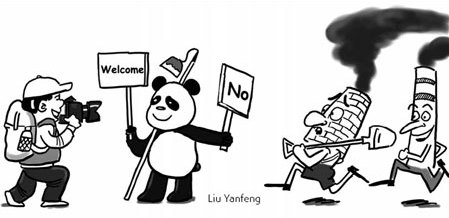Use the opportunity to build a better Sichuan

As media coverage of Wenchuan's May 12 earthquake gets relegated to the inner pages or mid-level news, it's apt to remind people outside the region that the recovery has now entered the longest and possibly the hardest phase. Given the scale of the destruction, the recovery is equally daunting, and, as the recently-published State's planning strategy states, "the task is arduous (and) time is pressing."
I lived through the earthquake (albeit at the periphery of its destruction), and I understand the profound impact it had on people's lives. I still suffer from nightmares every week, so I can imagine the trauma that people much worse-affected than me might be feeling. For these people, speedy reconstruction, economic rejuvenation and return to normalcy expedite the process of personal recovery.
At the same time, the destruction presents an opportunity to build back better, and that's more important than hasty rebuilding. The State's report sets ambitious goals aimed at bolstering and partially rearranging the human and economic geography in the affected area.
The report rightly identifies the limited carrying-capacity for population and industrial densities in the mountains, and that some resettlement needs to take place by industry and people moving to the Sichuan basin - this is the only safe and feasible long-term option (given the complex boundary faults in Sichuan's mountains, the prospect of future strong earthquakes isn't a question of if, but a matter of time). Sure, the task needs to be approached with urgency, but not at the expense of quality.
To this end it's good to see that despite the urgency in restoring peoples' livelihoods, other matters such as nature conservation and protection of intangible and tangible cultural or historical heritage are given due weight, forming part of the reconstruction itself.
For example, the report gives importance to the restoration of historical monuments, and the continuance of reforestation of marginal agricultural land on steep slopes - a program that has significantly expanded Sichuan's forest cover in less than a decade and achieved considerable containment of soil erosion.
Indeed, the policy document casts the reconstruction holistically. Now the next process is to add flesh and details to the overall strategy in every one of the counties and cities covered by the plan. Any detailed planning exercise has to reconcile many land-use conflicts, and planning is even more complex in the given context due to the uneven geography.
Different areas within the larger region pose different challenges and opportunities, and each area has to develop its own micro plan in a way that forms a piece in the jigsaw of the overall plan. That means holistic planning, and although the institutional capacity already exists, this is a special case that would benefit from the appointment of a body of experts to supervise the detailed plan.
Industry faces special challenges. How much industry should be allowed, and what industrial plants shall be redeveloped, and where? There are some tough choices to make in this area, and some industries cannot be relocated due to reasons ranging from social to geological.
The latter include mines, some of which were previously sources of river pollution, and now there is an opportunity to stringently enforce the State's policies by rebuilding potentially polluting industries with environmental and safety safeguards. After all, prevention is cheaper than costly clean-ups later on, as other countries have discovered on the path to development.
The policies even state that industries that pollute water or cannot be modernized have to be abandoned. Closing some anachronistic factories can be offset, in the medium term, by new ones that exploit the region's strength.
For example, the agricultural fertility of the Sichuan basin can give rise to more higher-value agro-industries that provide good returns, and this extends to the mountains, where more research can be done about the possibilities of cultivating some high-value produce such as medicinal herbs.
Tourism, another high-value industry, is pinpointed as a priority industry in its ability to catalyze the economic recovery. This cannot be emphasized enough: as someone who has worked in tourism for more than 15 years, I know that the mountains affected by the earthquake constitute a spectacular worldwide tourist attraction. Tourist attractions are even set to increase as earthquake memorials and new natural features (such as lakes) become part of an expanded package of allures.
Yet even before the earthquake, the tourism industry still had lots of room to grow. This is especially the case in terms of foreign visitors, whose numbers remain small in relation to the scale and eminence of attractions. The number of foreign visitors has the potential to rise exponentially with improved services, infrastructure, and accessibility.

And, once again, there is now an opportunity to carry out these improvements. Take Wolong Nature Reserve, for example, where most of the old hotels that existed before the earthquake flattened them were drab and uninspiring - the rebuilding provides a chance to build hotels that are funkier and cozier.
Additionally, importance should be placed on ecotourism, which is the most dynamic trend in tourism in our time. New hotels - and other tourism infrastructure - can strive for futurism by incorporating eco principles (such as energy efficiency, waste minimization, locally-sourced materials and food-stuffs, wise use of land, and so on).
Aside from saving money on energy in the long-term, green developments have the added values that they can be an attraction in their own right, creating visibility and customer satisfaction - in turn attracting more business.
In the same spirit, new residential homes and towns can incorporate greener design principles. The State's planning report emphasizes frugality in the use of land and energy, and this can be done in various ways. Buildings can be designed to be efficient on both counts - homes that are well insulated, conserve water, maximize the use of natural light and natural ventilation.
The concept can be extended to the design of towns by practical measures such as pedestrian-only town centers, level streets that facilitate cycling on short errands, and energy-efficient street-lighting (instead of globe lights, towns can have hooded light that direct the light down to the street where it is needed).
The report has set the ball rolling by policies that formulate a progressive strategic vision. Now that vision has to be translated into facts on the ground, and that's easier said than done. The hindrances are multifarious, including inertia and corruption at the local level, as well as local officials having their own interpretations.
Local officials have the advantage of local knowledge, but they can also become focused on local exigencies and fail to see the larger holistic picture beyond their neighborhood. Additionally, implementing high standards of planning requires a commensurate level of skills, innovation, and ideas. And these skills, everywhere in the world, are still in the early stages of evolution.
Hence a mechanism should be set up to ensure effective implementation. This could include a specially-formulated body of planning experts that can provide oversight and inject ideas in close cooperation with provincial and local officials.
Additionally, benefits can be reaped by fostering community involvement throughout the whole process. One advantage is that the communities would feel ownership of the reconstruction, and hence share some of the burdens of rebuilding; communities can also be a check on the efficiency and integrity of local officials.
Perhaps more importantly, the communities will be able to understand and see the process of strategic reconstruction, and if the reconstruction takes longer than envisaged, then local people would be patient and supportive.
In the Beijing Olympics, China set a new worldwide standard, in facilities and organization and in remaking Beijing, because the aim was high, the effort was intensely and diligently sustained, and experts were brought into the fold.
The experience gained in Beijing can be transposed to the reconstruction in Sichuan, where the effort has to be greater as the task is much bigger and expensive, and uniquely challenging.
The State's planning policy document has already set a high aim, and now it has to be nurtured and sustained on the ground for several years. Done effectively, that process would lead to a quality of life and prosperity that would be higher than the region enjoyed before the earthquake.
The author is a Maltese travel journalist
(China Daily 09/16/2008 page9)














